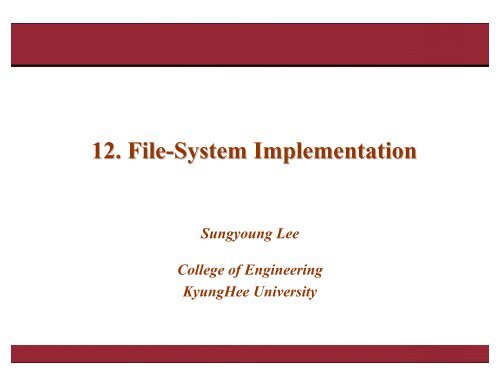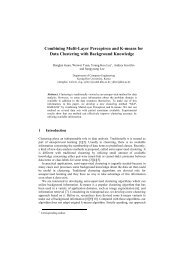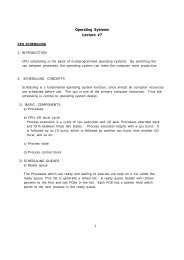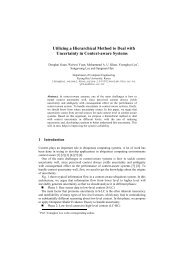12. File-System Implementation - Ubiquitous Computing Lab
12. File-System Implementation - Ubiquitous Computing Lab
12. File-System Implementation - Ubiquitous Computing Lab
Create successful ePaper yourself
Turn your PDF publications into a flip-book with our unique Google optimized e-Paper software.
<strong>12.</strong> <strong>File</strong>-<strong>System</strong> <strong>Implementation</strong><br />
Sungyoung Lee<br />
College of Engineering<br />
KyungHeeUniversity
Contents<br />
• <strong>File</strong> <strong>System</strong> Structure<br />
• <strong>File</strong> <strong>System</strong> <strong>Implementation</strong><br />
• Directory <strong>Implementation</strong><br />
• Allocation Methods<br />
• Free-Space Management<br />
• Efficiency and Performance<br />
• Recovery<br />
• Log-Structured <strong>File</strong> <strong>System</strong>s<br />
• NFS<br />
Operating <strong>System</strong> 1
Overview<br />
• User’s view on file systems:<br />
How files are named?<br />
What operations are allowed on them?<br />
What the directory tree looks like?<br />
• Implementor’s view on file systems:<br />
How files and directories are stored?<br />
How disk space is managed?<br />
How to make everything work efficiently and reliably?<br />
Operating <strong>System</strong> 2
<strong>File</strong>-<strong>System</strong> Structure<br />
• <strong>File</strong> structure<br />
Logical storage unit<br />
Collection of related information<br />
• <strong>File</strong> system resides on secondary storage (disks)<br />
• <strong>File</strong> system organized into layers<br />
• <strong>File</strong> control block<br />
storage structure consisting of information about a file<br />
Operating <strong>System</strong> 3
Layered <strong>File</strong> <strong>System</strong><br />
Operating <strong>System</strong> 4
A Typical <strong>File</strong> Control Block<br />
Operating <strong>System</strong> 5
• On-disk structure<br />
Boot control block<br />
• Boot block(UFS) or Boot sector(NTFS)<br />
Partition control block<br />
• Super block(UFS) or Master file table(NTFS)<br />
Directory structure<br />
<strong>File</strong> control block (FCB)<br />
• I-node(UFS) or In master file table(NTFS)<br />
<strong>File</strong>-<strong>System</strong> <strong>Implementation</strong><br />
• In-memory structure<br />
In-memory partition table<br />
In-memory directory structure<br />
<strong>System</strong>-wide open file table<br />
Per-process open file table<br />
Operating <strong>System</strong> 6
On-Disk Structure<br />
boot code<br />
partition table<br />
Master Boot Record<br />
boot block<br />
super block<br />
bitmaps<br />
i-nodes<br />
: fs metadata<br />
(type, # blocks, etc.)<br />
: data structures for<br />
free space mgmt.<br />
: file metadata<br />
Partition 1<br />
(active)<br />
FSdependent<br />
root dir<br />
Partition 2<br />
Partition 3<br />
files<br />
&<br />
directories<br />
Operating <strong>System</strong> 7
In-Memory Structure<br />
process A<br />
file table<br />
(system-wide<br />
open-file table)<br />
count<br />
offset<br />
file attributes<br />
in-memory<br />
partition table<br />
per-process<br />
file descriptor table<br />
(per-process open-file table)<br />
process B<br />
directory cache<br />
buffer cache<br />
Operating <strong>System</strong> 8
In-Memory <strong>File</strong> <strong>System</strong> Structures<br />
• The following figure illustrates the necessary file system structures provided<br />
by the operating systems<br />
• Figure 12-3(a) refers to opening a file<br />
• Figure 12-3(b) refers to reading a file<br />
Operating <strong>System</strong> 9
In-Memory <strong>File</strong> <strong>System</strong> Structures<br />
Operating <strong>System</strong> 10
Virtual <strong>File</strong> <strong>System</strong>s<br />
• Virtual <strong>File</strong> <strong>System</strong>s (VFS) provide an object-oriented way of implementing<br />
file systems<br />
• VFS allows the same system call interface (the API) to be used for different<br />
types of file systems<br />
• The API is to the VFS interface, rather than any specific type of file system<br />
Operating <strong>System</strong> 11
Schematic View of Virtual <strong>File</strong> <strong>System</strong><br />
Operating <strong>System</strong> 12
<strong>File</strong> <strong>System</strong> Internals<br />
<strong>System</strong> call interface<br />
Virtual <strong>File</strong> <strong>System</strong> (VFS)<br />
minix<br />
nfs<br />
ext2<br />
… dosfs mmfs<br />
procfs<br />
buffer cache<br />
<strong>File</strong> <strong>System</strong><br />
device driver<br />
Operating <strong>System</strong> 13
• Virtual <strong>File</strong> <strong>System</strong><br />
Manages kernel-level file abstractions in one format for all file systems<br />
Receives system call requests from user-level (e.g., open, write, stat, etc.)<br />
Interacts with a specific file system based on mount point traversal<br />
Receives requests from other parts of the kernel, mostly from memory<br />
management<br />
Translates file descriptors to VFS data structures (such as vnode)<br />
• Linux: VFS common file model<br />
The superblock object<br />
• stores information concerning a mounted file system<br />
The inode object<br />
• stores general information about a specific file<br />
The file object<br />
• stores information about the interaction between an open file and a process<br />
The dentry object<br />
• stores information about the linking of a directory entry with the corresponding file<br />
VFS<br />
Operating <strong>System</strong> 14
Directory <strong>Implementation</strong><br />
• Linear list of file names with pointer to the data blocks<br />
simple to program<br />
time-consuming to execute<br />
• Hash Table<br />
linear list with hash data structure<br />
decreases directory search time<br />
collisions<br />
• situations where two file names hash to the same location<br />
fixed size<br />
Operating <strong>System</strong> 15
Directory <strong>Implementation</strong><br />
• The location of metadata<br />
In the directory entry<br />
“foo”<br />
“bar”<br />
owner, size, ACL,<br />
access time, location, …<br />
owner, size, ACL,<br />
access time, location, …<br />
In the separate<br />
data structure<br />
(e.g., i-node)<br />
“foo”<br />
“bar”<br />
…<br />
owner<br />
size<br />
ACL<br />
access time<br />
location, …<br />
owner<br />
size<br />
ACL<br />
access time<br />
location, …<br />
A hybrid approach<br />
“foo”<br />
location<br />
owner, size, …<br />
“bar”<br />
location<br />
owner, size, …<br />
Operating <strong>System</strong> 16
Allocation Methods<br />
• An allocation method refers to how disk blocks are allocated for files<br />
Contiguous allocation<br />
Linked allocation<br />
Indexed allocation<br />
Operating <strong>System</strong> 17
Contiguous Allocation<br />
• Each file occupies a set of contiguous blocks on the disk<br />
• Simple<br />
only starting location (block #) and length (number of blocks) are required<br />
• Random access<br />
• Wasteful of space (dynamic storage-allocation problem)<br />
• <strong>File</strong>s cannot grow<br />
Operating <strong>System</strong> 18
Contiguous Allocation of Disk Space<br />
Operating <strong>System</strong> 19
Extent-Based <strong>System</strong>s<br />
• Many newer file systems (I.e. Veritas <strong>File</strong> <strong>System</strong>) use a modified contiguous<br />
allocation scheme<br />
• Extent-based file systems allocate disk blocks in extents<br />
• An extent is a contiguous block of disks<br />
Extents are allocated for file allocation<br />
A file consists of one or more extents<br />
Operating <strong>System</strong> 20
• Advantages<br />
The number of disk seeks is minimal<br />
Directory entries can be simple:<br />
<br />
Contiguous Allocation<br />
• Disadvantages<br />
Requires a dynamic storage allocation: First / best fit<br />
External fragmentation: may require a compaction<br />
The file size is hard to predict and varying over time<br />
• Feasible and widely used for CD-ROMS<br />
All the file sizes are known in advance<br />
<strong>File</strong>s will never change during subsequent use<br />
Operating <strong>System</strong> 21
Linked Allocation<br />
• Each file is a linked list of disk blocks<br />
Blocks may be scattered anywhere on the disk<br />
block =<br />
pointer<br />
Operating <strong>System</strong> 22
Linked Allocation (Cont’d)<br />
• Simple<br />
need only starting address<br />
• Free-space management system<br />
no waste of space<br />
• No random access<br />
• <strong>File</strong>-allocation table (FAT)<br />
disk-space allocation used by MS-DOS and OS/2<br />
Operating <strong>System</strong> 23
Linked Allocation<br />
Operating <strong>System</strong> 24
<strong>File</strong>-Allocation Table<br />
Operating <strong>System</strong> 25
• Advantages<br />
Directory entries are simple:<br />
<br />
No external fragmentation<br />
• the disk blocks may be scattered anywhere on the disk<br />
A file can continue to grow as long as free blocks are available<br />
Linked Allocation<br />
• Disadvantages<br />
It can be used only for sequentially accessed files<br />
Space overhead for maintaining pointers to the next disk block<br />
The amount of data storage in a block is no longer a power of two because the<br />
pointer takes up a few bytes<br />
Fragile: a pointer can be lost or damaged<br />
Operating <strong>System</strong> 26
Linked Allocation using Clusters<br />
• Collect blocks into multiples (clusters) and allocate the clusters to files<br />
e.g., 4 blocks / 1 cluster<br />
• Advantages<br />
The logical-to-physical block mapping remains simple<br />
Improves disk throughput (fewer disk seeks)<br />
Reduced space overhead for pointers<br />
• Disadvantages<br />
Internal fragmentation<br />
Operating <strong>System</strong> 27
Indexed Allocation<br />
• Brings all pointers together into the index block<br />
• Logical view<br />
index table<br />
• Need index table<br />
• Random access<br />
• Dynamic access without external fragmentation, but have overhead of index<br />
block<br />
Operating <strong>System</strong> 28
Example of Indexed Allocation<br />
Operating <strong>System</strong> 29
Indexed Allocation – Mapping (Cont’d)<br />
Μ<br />
outer-index<br />
index table<br />
file<br />
Operating <strong>System</strong> 30
Combined Scheme: UNIX (4K bytes per block)<br />
Operating <strong>System</strong> 31
• Advantages<br />
Indexed Allocation<br />
Supports direct access, without suffering from external fragmentation<br />
I-node need only be in memory when the corresponding file is open<br />
• Disadvantages<br />
Space overhead for indexes:<br />
(1) Linked scheme: link several index blocks<br />
(2) Multilevel index blocks<br />
(3) Combined scheme: UNIX<br />
-12 direct blocks, single indirect block, double indirect block,<br />
triple indirect block<br />
Operating <strong>System</strong> 32
Free-Space Management<br />
• Bit vector (n blocks)<br />
0 1 2 n-1<br />
…<br />
bit[i] =<br />
1 ⇒ block[i] free<br />
0 ⇒ block[i] occupied<br />
Block number calculation<br />
(number of bits per word) *<br />
(number of 0-value words) +<br />
offset of first 1 bit<br />
Operating <strong>System</strong> 33
Free-Space Management (Cont’d)<br />
• Bit map requires extra space. Example:<br />
block size = 2 12 bytes<br />
disk size = 2 30 bytes (1 gigabyte)<br />
n = 2 30 /2 12 = 2 18 bits (or 32K bytes)<br />
• Easy to get contiguous files<br />
• Linked list (free list)<br />
Cannot get contiguous space easily<br />
No waste of space<br />
• Grouping<br />
• Counting<br />
Operating <strong>System</strong> 34
Linked Free Space List on Disk<br />
Operating <strong>System</strong> 35
• Grouping<br />
Store the addresses of n free blocks in the first free block<br />
Free Space Management<br />
The addresses of a large number of free blocks can be found quickly<br />
• Counting<br />
Keep the address of the free block and the number of free contiguous blocks<br />
The length of the list becomes shorter and the count is generally greater than 1<br />
• Several contiguous blocks may be allocated or freed simultaneously<br />
Operating <strong>System</strong> 36
Efficiency and Performance<br />
• Efficiency dependent on:<br />
Disk allocation and directory algorithms<br />
Types of data kept in file’s directory entry<br />
• Performance<br />
Disk cache<br />
• separate section of main memory for frequently used blocks<br />
Free-behind and Read-ahead<br />
• techniques to optimize sequential access<br />
Improve PC performance by dedicating section of memory as virtual disk, or RAM<br />
disk<br />
Operating <strong>System</strong> 37
• Applications exhibit significant locality for reading and writing files<br />
Buffer Cache<br />
• Idea: cache file blocks in memory to capture locality in buffer cache (or disk<br />
cache)<br />
Cache is system wide, used and shared by all processes<br />
Reading from the cache makes a disk perform like memory<br />
Even a 4MB cache can be very effective<br />
• Issues<br />
The buffer cache competes with VM<br />
Like VM, it has limited size<br />
Need replacement algorithms again<br />
(References are relatively infrequent, so it is feasible to keep all the blocks in<br />
exact LRU order)<br />
Operating <strong>System</strong> 38
Various Disk-Caching Locations<br />
Operating <strong>System</strong> 39
Page Cache<br />
• A page cache caches pages rather than disk blocks using virtual memory<br />
techniques<br />
• Memory-mapped I/O uses a page cache<br />
• Routine I/O through the file system uses the buffer (disk) cache<br />
• This leads to the following figure<br />
Operating <strong>System</strong> 40
I/O Without a Unified Buffer Cache<br />
Operating <strong>System</strong> 41
Unified Buffer Cache<br />
• A unified buffer cache uses the same page cache to cache both memorymapped<br />
pages and ordinary file system I/O<br />
Operating <strong>System</strong> 42
Caching Writes<br />
• Synchronous writes are very slow<br />
• Asynchronous writes (or write-behind, write-back)<br />
Maintain a queue of uncommitted blocks<br />
Periodically flush the queue to disk<br />
Unreliable: metadata requires synchronous writes (with small files, most writes<br />
are to metadata)<br />
Operating <strong>System</strong> 43
• <strong>File</strong> system predicts that the process will request next block<br />
<strong>File</strong> system goes ahead and requests it from the disk<br />
Read-Ahead<br />
This can happen while the process is computing on previous block, overlapping<br />
I/O with execution<br />
When the process requests block, it will be in cache<br />
• Compliments the disk cache, which also is doing read ahead<br />
• Very effective for sequentially accessed files<br />
• <strong>File</strong> systems try to prevent blocks from being scattered across the disk during<br />
allocation or by restructuring periodically<br />
• Cf) Free-behind<br />
Operating <strong>System</strong> 44
• Block size<br />
Block Size Performance vs. Efficiency<br />
Disk block size vs. file system block size<br />
The median file size in UNIX is about 1KB<br />
100<br />
Block size<br />
(All files are 2KB)<br />
Operating <strong>System</strong> 45
Recovery<br />
• Consistency checking<br />
compares data in directory structure with data blocks on disk, and tries to fix<br />
inconsistencies<br />
• Use system programs to back up data from disk to another storage device<br />
(floppy disk, magnetic tape)<br />
• Recover lost file or disk by restoring data from backup<br />
Operating <strong>System</strong> 46
• <strong>File</strong> system consistency<br />
Reliability<br />
<strong>File</strong> system can be left in an inconsistent state if cached blocks are not written out<br />
due to the system crash<br />
It is especially critical if some of those blocks are i-node blocks, directory blocks,<br />
or blocks containing the free list<br />
Most systems have a utility program that checks file system consistency<br />
• Windows: scandisk<br />
• UNIX: fsck<br />
Operating <strong>System</strong> 47
Log Structured <strong>File</strong> <strong>System</strong>s<br />
• Log structured (or journaling) file systems record each update to the file<br />
system as a transaction<br />
• All transactions are written to a log<br />
A transaction is considered committed once it is written to the log<br />
However, the file system may not yet be updated<br />
• The transactions in the log are asynchronously written to the file system<br />
When the file system is modified, the transaction is removed from the log<br />
• If the file system crashes, all remaining transactions in the log must still be<br />
performed<br />
Operating <strong>System</strong> 48
• Journaling file systems<br />
Log Structured <strong>File</strong> <strong>System</strong>s<br />
Fsck’ing takes a long time, which makes the file system restart slow in the event<br />
of system crash<br />
Record a log, or journal, of changes made to files and directories to a separate<br />
location (preferably a separate disk)<br />
If a crash occurs, the journal can be used to undo any partially completed tasks<br />
that would leave the file system in an inconsistent state<br />
IBM JFS for AIX, Linux<br />
Veritas VxFS for Solaris, HP-UX, Unixware, etc.<br />
SGI XFS for IRIX, Linux<br />
Reiserfs, ext3 for Linux<br />
NTFS for Windows<br />
Operating <strong>System</strong> 49
The Sun Network <strong>File</strong> <strong>System</strong> (NFS)<br />
• An implementation and a specification of a software system for accessing<br />
remote files across LANs (or WANs)<br />
• The implementation is part of the Solaris and SunOS operating systems<br />
running on Sun workstations using an unreliable datagram protocol (UDP/IP<br />
protocol and Ethernet)<br />
Operating <strong>System</strong> 50
NFS (Cont’d)<br />
• Interconnected workstations viewed as a set of independent machines with<br />
independent file systems, which allows sharing among these file systems in a<br />
transparent manner<br />
A remote directory is mounted over a local file system directory. The mounted<br />
directory looks like an integral subtree of the local file system, replacing the<br />
subtree descending from the local directory<br />
Specification of the remote directory for the mount operation is nontransparent;<br />
the host name of the remote directory has to be provided. <strong>File</strong>s in the remote<br />
directory can then be accessed in a transparent manner<br />
Subject to access-rights accreditation, potentially any file system (or directory<br />
within a file system), can be mounted remotely on top of any local directory<br />
Operating <strong>System</strong> 51
NFS (Cont’d)<br />
• NFS is designed to operate in a heterogeneous environment of different<br />
machines, operating systems, and network architectures<br />
The NFS specifications independent of these media<br />
• This independence is achieved through the use of RPC primitives built on top<br />
of an External Data Representation (XDR) protocol used between two<br />
implementation-independent interfaces<br />
• The NFS specification distinguishes between the services provided by a<br />
mount mechanism and the actual remote-file-access services<br />
Operating <strong>System</strong> 52
Three Independent <strong>File</strong> <strong>System</strong>s<br />
Operating <strong>System</strong> 53
Mounting in NFS<br />
Mounts<br />
Cascading mounts<br />
Operating <strong>System</strong> 54
NFS Mount Protocol<br />
• Establishes initial logical connection between server and client<br />
• Mount operation includes name of remote directory to be mounted and name<br />
of server machine storing it<br />
Mount request is mapped to corresponding RPC and forwarded to mount server<br />
running on server machine<br />
Export list – specifies local file systems that server exports for mounting, along<br />
with names of machines that are permitted to mount them<br />
• Following a mount request that conforms to its export list, the server returns<br />
a file handle — a key for further accesses<br />
• <strong>File</strong> handle<br />
A file-system identifier, and an inode number to identify the mounted directory<br />
within the exported file system<br />
• The mount operation changes only the user’s view and does not affect the<br />
server side<br />
Operating <strong>System</strong> 55
NFS Protocol<br />
• Provides a set of remote procedure calls for remote file operations<br />
• The procedures support the following operations:<br />
searching for a file within a directory<br />
reading a set of directory entries<br />
manipulating links and directories<br />
accessing file attributes<br />
reading and writing files<br />
• NFS servers are stateless<br />
Each request has to provide a full set of arguments<br />
• Modified data must be committed to the server’s disk before results are<br />
returned to the client (lose advantages of caching)<br />
• The NFS protocol does not provide concurrency-control mechanisms<br />
Operating <strong>System</strong> 56
Three Major Layers of NFS Architecture<br />
• UNIX file-system interface<br />
Based on the open, read, write, and close calls, and file descriptors<br />
• Virtual <strong>File</strong> <strong>System</strong> (VFS) layer<br />
Distinguishes local files from remote ones, and local files are further distinguished<br />
according to their file-system types<br />
The VFS activates file-system-specific operations to handle local requests<br />
according to their file-system types<br />
Calls the NFS protocol procedures for remote requests<br />
• NFS service layer<br />
Bottom layer of the architecture<br />
Implements the NFS protocol<br />
Operating <strong>System</strong> 57
Schematic View of NFS Architecture<br />
Operating <strong>System</strong> 58
NFS Path-Name Translation<br />
• Performed by breaking the path into component names and performing a<br />
separate NFS lookup call for every pair of component name and directory<br />
vnode<br />
• To make lookup faster, a directory name lookup cache on the client’s side<br />
holds the vnodes for remote directory names<br />
Operating <strong>System</strong> 59
NFS Remote Operations<br />
• Nearly one-to-one correspondence between regular UNIX system calls and<br />
the NFS protocol RPCs (except opening and closing files)<br />
• NFS adheres to the remote-service paradigm, but employs buffering and<br />
caching techniques for the sake of performance<br />
• <strong>File</strong>-blocks cache<br />
When a file is opened, the kernel checks with the remote server whether to fetch<br />
or revalidate the cached attributes<br />
Cached file blocks are used only if the corresponding cached attributes are up to<br />
date<br />
• <strong>File</strong>-attribute cache<br />
The attribute cache is updated whenever new attributes arrive from the server<br />
• Clients do not free delayed-write blocks until the server confirms that the data<br />
have been written to disk<br />
Operating <strong>System</strong> 60
Appendix) <strong>Implementation</strong><br />
Examples
• Fast file system (FFS)<br />
Fast <strong>File</strong> <strong>System</strong><br />
The original Unix file system (70’s) was very simple and straightforwardly<br />
implemented:<br />
• Easy to implement and understand<br />
• But very poor utilization of disk bandwidth (lots of seeking)<br />
BSD Unix folks redesigned file system called FFS<br />
• McKusick, Joy, Fabry, and Leffler (mid 80’s)<br />
• Now it is the file system from which all other UNIX file systems have been compared<br />
The basic idea is aware of disk structure<br />
• Place related things on nearby cylinders to reduce seeks<br />
• Improved disk utilization, decreased response time<br />
Operating <strong>System</strong> 62
• Data and i-node placement<br />
Original Unix FS had two major problems:<br />
(1) Data blocks are allocated randomly in aging file systems<br />
• Blocks for the same file allocated sequentially when FS is new<br />
Fast <strong>File</strong> <strong>System</strong> (Cont’d)<br />
• As FS “ages” and fills, need to allocate blocks freed up when other files are deleted<br />
• Problem: Deleted files essentially randomly placed<br />
• So, blocks for new files become scattered across the disk<br />
(2) i-nodes are allocated far from blocks<br />
• All i-nodes at the beginning of disk, far from data<br />
• Traversing file name paths, manipulating files and directories require going back and<br />
forth from i-nodes to data blocks<br />
Both of these problems generate many long seeks!<br />
Operating <strong>System</strong> 63
• Cylinder groups<br />
Fast <strong>File</strong> <strong>System</strong> (Cont’d)<br />
BSD FFS addressed these problems using the notion of a cylinder group<br />
Disk partitioned into groups of cylinders<br />
Data blocks from a file all placed in the same cylinder group<br />
<strong>File</strong>s in same directory placed in the same cylinder group<br />
I-nodes for files allocated in the same cylinder group as file’s data blocks<br />
Operating <strong>System</strong> 64
• Free space reserved across all cylinders.<br />
Fast <strong>File</strong> <strong>System</strong> (Cont’d)<br />
If the number of free blocks falls to zero, the file system throughput tends to be<br />
cut in half, because of the inability to localize blocks in a file<br />
A parameter, called free space reserve, gives the minimum acceptable<br />
percentage of file system blocks that should be free<br />
If the number of free blocks drops below this level, only the system administrator<br />
can continue to allocate blocks<br />
Normally 10%; this is why df may report > 100%<br />
Operating <strong>System</strong> 65
• Fragments<br />
Small blocks (1KB) caused two problems:<br />
• Low bandwidth utilization<br />
• Small max file size (function of block size)<br />
FFS fixes by using a larger block (4KB)<br />
• Allows for very large files<br />
(1MB only uses 2 level indirect)<br />
Fast <strong>File</strong> <strong>System</strong> (Cont’d)<br />
• But introduces internal fragmentation: there are many small files (i.e., < 4KB)<br />
FFS introduces “fragments” to fix internal fragmentation<br />
• Allows the division of a block into one or more fragments (1K pieces of a block)<br />
Operating <strong>System</strong> 66
Fast <strong>File</strong> <strong>System</strong> (Cont’d)<br />
• Media failures<br />
Replicate master block (superblock)<br />
• <strong>File</strong> system parameterization<br />
Parameterize according to disk and CPU characteristics<br />
• Maximum blocks per file in a cylinder group<br />
• Minimum percentage of free space<br />
• Sectors per track<br />
• Rotational delay between contiguous blocks<br />
• Tracks per cylinder, etc.<br />
Skip according to rotational rate and CPU latency<br />
Operating <strong>System</strong> 67
• History<br />
Evolved from Minix file system<br />
Linux Ext2 <strong>File</strong> <strong>System</strong><br />
• Block addresses are stored in 16bit integers – maximal file system size is restricted to<br />
64MB<br />
• Directories contain fixed-size entries and the maximal file name was 14 characters<br />
Virtual <strong>File</strong> <strong>System</strong> (VFS) is added<br />
Extended <strong>File</strong>system (Ext FS), 1992<br />
• Added to Linux 0.96c<br />
• Maximum file system size was 2GB, and the maximal file name size was 255<br />
characters<br />
Second Extended <strong>File</strong>-system (Ext2 FS), 1994<br />
Operating <strong>System</strong> 68
Linux Ext2 <strong>File</strong> <strong>System</strong> (Cont’d)<br />
• Ext2 Features<br />
Configurable block sizes (from 1KB to 4KB)<br />
• depending on the expected average file size<br />
Configurable number of i-nodes<br />
• depending on the expected number of files<br />
Partitions disk blocks into groups<br />
• lower average disk seek time<br />
Preallocates disk data blocks to regular files<br />
• reduces file fragmentation<br />
Fast symbolic links<br />
• If the pathname of the symbolic link has 60 bytes or less, it is stored in the i-node<br />
Automatic consistency check at boot time<br />
Operating <strong>System</strong> 69
• Disk layout<br />
Boot block<br />
• reserved for the partition boot sector<br />
Block group<br />
• Similar to the cylinder group in FFS<br />
Linux Ext2 <strong>File</strong> <strong>System</strong> (Cont’d)<br />
• All the block groups have the same size and are stored sequentially<br />
Boot<br />
Block<br />
Block group 0<br />
Block group n<br />
Super<br />
Block<br />
Group<br />
Descriptors<br />
Data block<br />
Bitmap<br />
i-node<br />
Bitmap<br />
i-node<br />
Table<br />
Data blocks<br />
1 block n blocks 1 block 1 block n block n blocks<br />
Operating <strong>System</strong> 70
• Block group<br />
Superblock: stores file system metadata<br />
• Total number of i-nodes<br />
• <strong>File</strong> system size in blocks<br />
• Free blocks / i-nodes counter<br />
• Number of blocks / i-nodes per group<br />
• Block size, etc.<br />
Group descriptor<br />
Linux Ext2 <strong>File</strong> <strong>System</strong> (Cont’d)<br />
• Number of free blocks / i-nodes / directories in the group<br />
• Block number of block / i-node bitmap, etc.<br />
Both the superblock and the group descriptors are duplicated in each block group<br />
• Only those in block group 0 are used by the kernel<br />
• fsck copies them into all other block groups<br />
• When data corruption occurs, fsck uses old copies to bring the file system back to a<br />
consistent state<br />
Operating <strong>System</strong> 71
• Block group size<br />
The block bitmap must be stored in a single block<br />
Linux Ext2 <strong>File</strong> <strong>System</strong> (Cont’d)<br />
• In each block group, there can be at most 8xb blocks, where b is the block size in bytes<br />
The smaller the block size, the larger the number of block groups<br />
Example: 8GB Ext2 partition with 4KB block size<br />
• Each 4KB block bitmap describes 32K data blocks<br />
= 32K * 4KB = 128MB<br />
• At most 64 block groups are needed<br />
Operating <strong>System</strong> 72
Linux Ext2 <strong>File</strong> <strong>System</strong> (Cont’d)<br />
• Directory structure<br />
inode<br />
record<br />
length<br />
name<br />
0<br />
12<br />
24<br />
40<br />
62<br />
68<br />
21<br />
22<br />
53<br />
67<br />
0<br />
34<br />
12 1 2 . \0 \0 \0<br />
12 2 2 . . \0 \0<br />
16 5 2 h o m e 1 \0 \0 \0<br />
28 3 2 u s r \0<br />
16 7 1 o l d f i l e \0<br />
12 3 2 b i n \0<br />
<br />
name length<br />
file type<br />
Operating <strong>System</strong> 73










